The 30 most impressive science fair projects in the country
Audrey Glende (12) wants to save the fish — in your aquarium.

Andrew Eggebraaten (14) designed a sophisticated robotic hand.
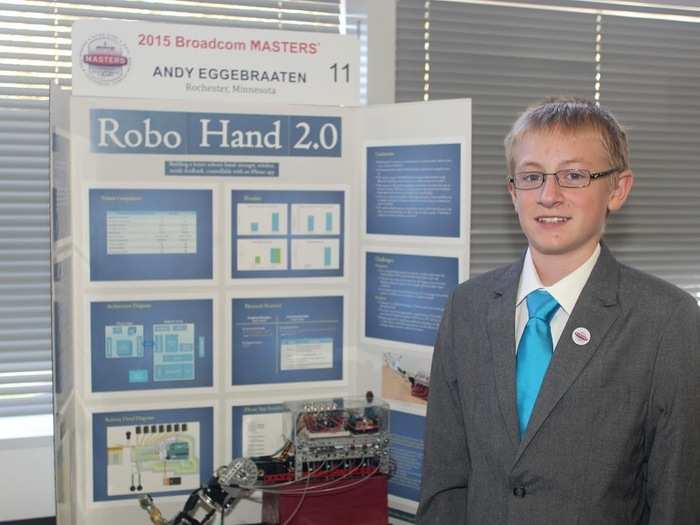
There are a lot of prosthetics on the market, but there's nothing quite like Andrew Eggebraaten's robotic hand, which can perform 58 different tasks. Even more impressive, the hand responds to voice commands and can change how hard it squeezes an object.
At just 14, Eggebraaten is already an expert in electronics — he even taught LEGO Robotics to younger students this summer.
Anish SinghaniI (13) developed technology for people with paralysis.
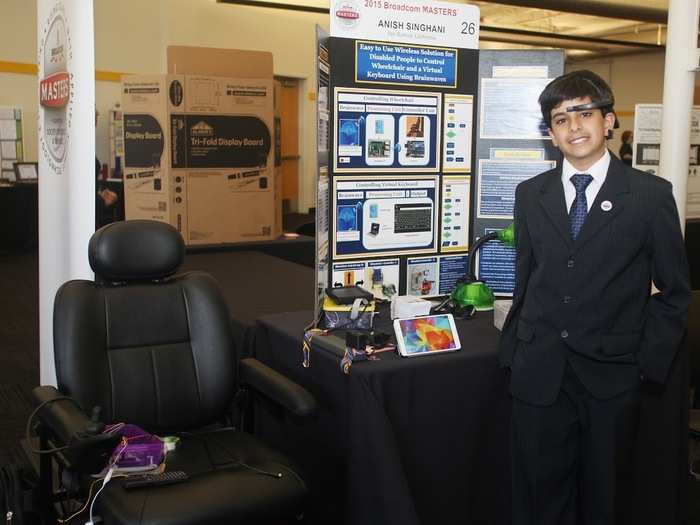
Anish Singhanil has his own YouTube channel "iShareTech" and says that engineering and technology are his 'relaxation tool.' For his project, Singhanil designed both hardware and software to enable a commercial brain-wave sensor device to communicate with a wheelchair and virtual keyboard.
Singhanil hopes that his technology will improve the quality of life for those who are paralyzed. He has also designed a number of apps, which you can download on Google Play.
Anusha Zaman (14) studied the health affects of the betel plant.
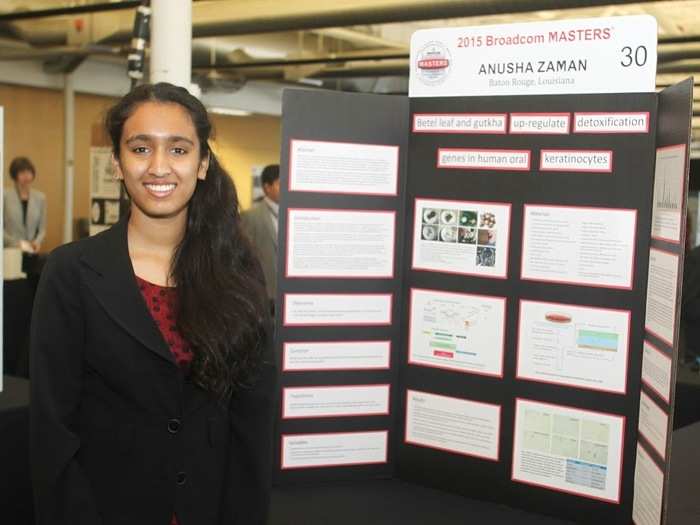
Largely mysterious to Westerners, the betel plant is a common stimulant in many chewing products throughout Asia. Anusha Zaman became intrigued by the health effects of this plant, so she tested it on some mouth cells that she grew in a university lab.
She discovered that the betel-based products she tested changed how some of the cells expressed different genes, meaning that betel could be harmful to human health, Zaman concluded. Other studies have found similar adverse health effects of betel.
Avery Clowes (13) built and tested a machine that generated electricity from running water.
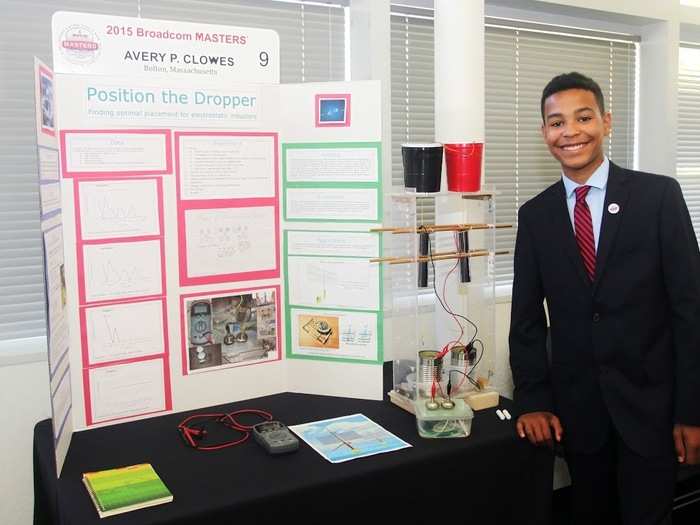
Avery Clowes knows his history. For his project, Clowes built and studied a famous physics experiment first designed in the 19th century called Lord Kelvin’s Water Dropper. The experiment generates electricity with nothing more than metal wires and streams of water that flow into two separate buckets.
Clowes discovered that he could control the amount of electricity the system produced by slightly altering how close, or far, the metal loops were from the surface of the water-filling buckets.
Blake Caven (12) designed a video game, but that's just the beginning.
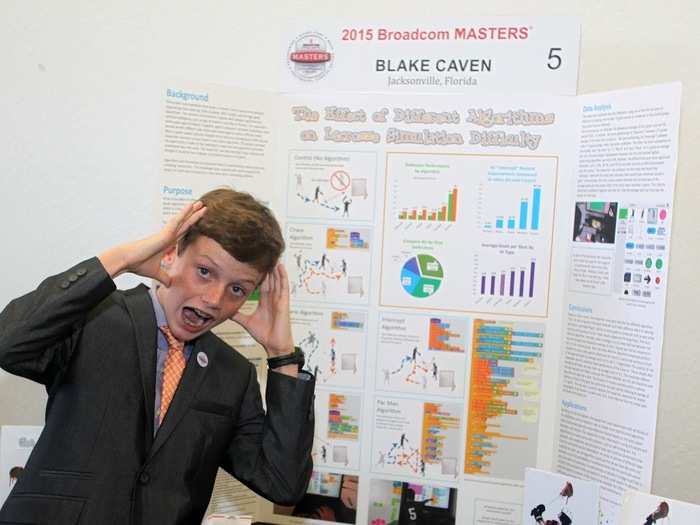
Most 12-year-old boys enjoy playing video games, but Blake Caven also enjoys designing them — an difficult task that requires a mature understanding of computer coding languages. For his project, Caven wrote the software for a lacrosse simulation game that involved a sophisticated level of gameplay with five types of computer-generated Defenders.
Caven eventually wants to use his computer coding skills to build simulations to create real-world solutions.
Bryant Liu (13) figured out what to do with all of those dead leaves you're raking up.
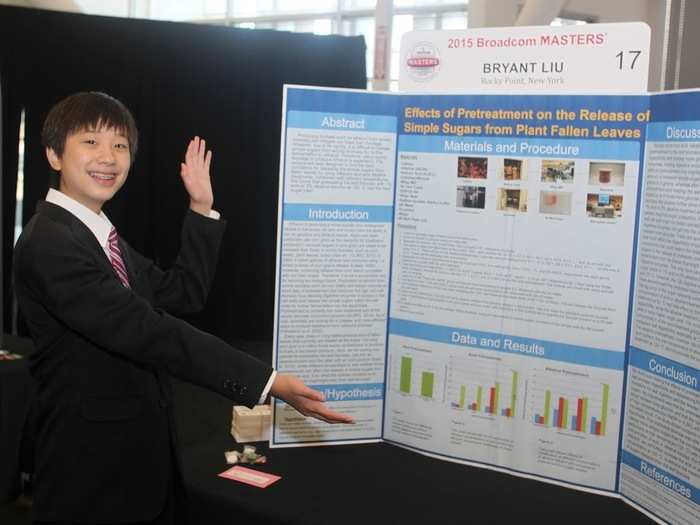
Current technology can generate fuel, in the form of ethanol, from corn and sugar cane, but Bryan Liu wanted to know if the same could be done with the fallen leaves he rakes up every fall.
Leaves are rich in cellulose, which is relatively hard to break down into usable energy, but Liu discovered a special chemical cocktail that you can pre-treat leaves with to ease the process. Liu hopes to study astronomy in college.
Carolyn Almonte (12) studied the health effects of a common house-hold chemical.
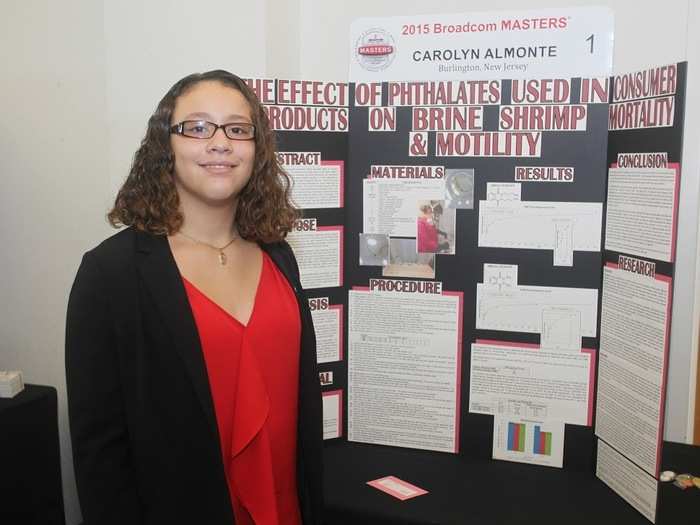
Carolyn Almontel plays the Frenh horn and swims for a local YMCA team, but she's also concerned with the potentially harmful effects of a certain chemical called pthalates on human health.
As a first step, Almontel's science project discovered that two different types of pthalates — which are in house-hold items like deodorant and nail polish — had neurotoxic effects on brine shrimp. Other studies on lab animals have yielded similar effects.
David Yue (14) has a new way to diagnose cancer.
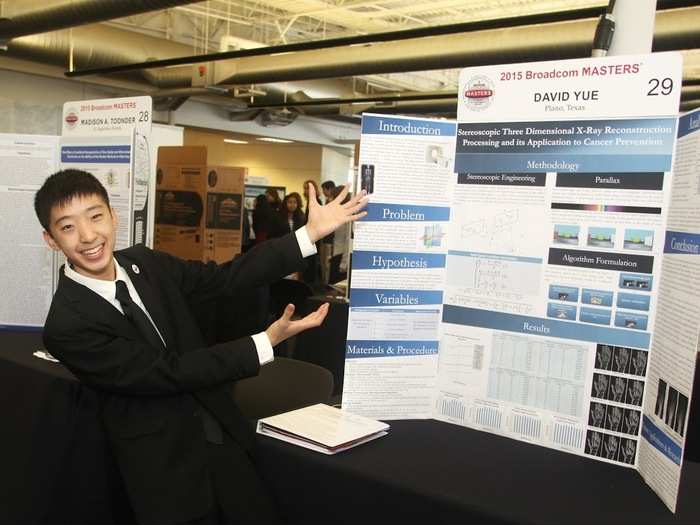
David Yue is searching for ways to improve cancer diagnostic methods. Instead of taking multiple X-ray scans on a single patient — a process that exposes them to relatively high radiation levels — and then analyzing the scans one-by-one, Yue suggests constructing a 3D image from two X-ray images.
Yue's tests did not show that his method was unequivocally superior to current methods, but he hopes to continue working out the details and envisions a future where his methods can replace current tests, thus reducing patients' level of radiation exposure.
Elizabeth Kinsey (14) wants to protect her neighborhood friend: the oyster.
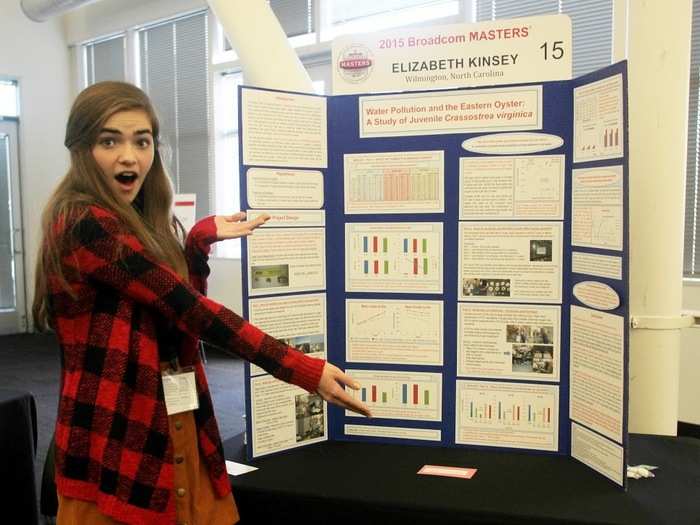
Living on the coast, Elizabeth Kinsey was curious to learn if the fertilizers and pesticides in runoff effect the growth of exposed oyster beds. She tested how a number of different chemicals found in fertilizers and pesticides affect oyster growth.
One type of insecticide, carbaryl, did not harm oyster development while high amounts of fertilizer killed them, Kinsey reported, but she also says she'd like to continue testing other chemicals and asserts that runoff should be regulated to promote oyster growth.
Evelyn Bodoni (13) caught her fellow students cheating.
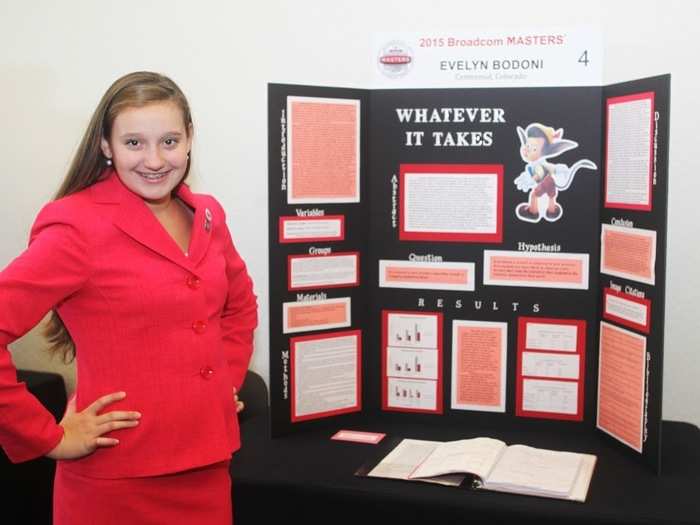
For her project, Evelyn Bodoni had a watchful eye on some of her classmates. Bodoni investigated the prevalence of cheating by recruiting 36 students in grades 5 through 8 wherein they were given a test with answers on the back but asked to finish without cheating.
The first group of students were promised a reward if they scored 80% or higher and the second were promised nothing. Bodoni found that 81% of students in the reward test group cheated and 40% cheated who were in the second group cheated. She wants to study law.
Glenn Grimmett (13) has some disturbing news about your milk.
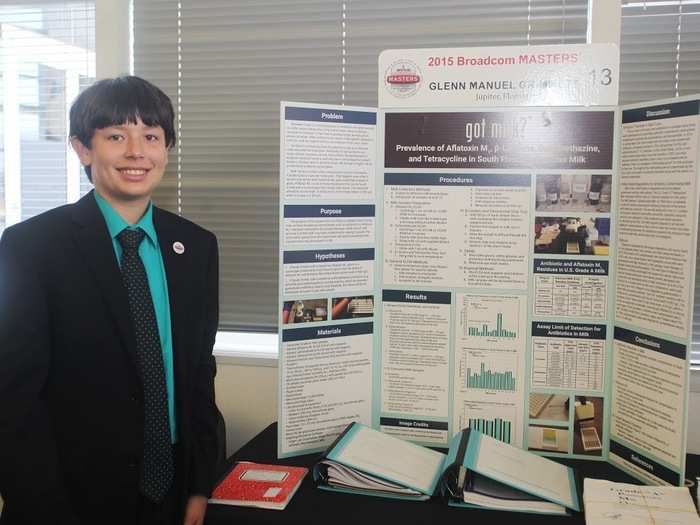
Glenn Grimmett discovered something rather disturbing for his project, which searched for levels of carcinogens and antibiotics in milk bought from local groceries. US farmers are supposed to discard milk if they detect any traces of antiobiotics.
Grimmett used tests that are 30 to 40 times more sensitive than FDA approved tests, and he discovered the presence of two different antiobiotics in 17 out of his 25 samples. "New technology is needed to improve antibiotic detection in milk," the 13-year-old concluded.
Hannah Cevasco (14) discovered the healing powers of honey.
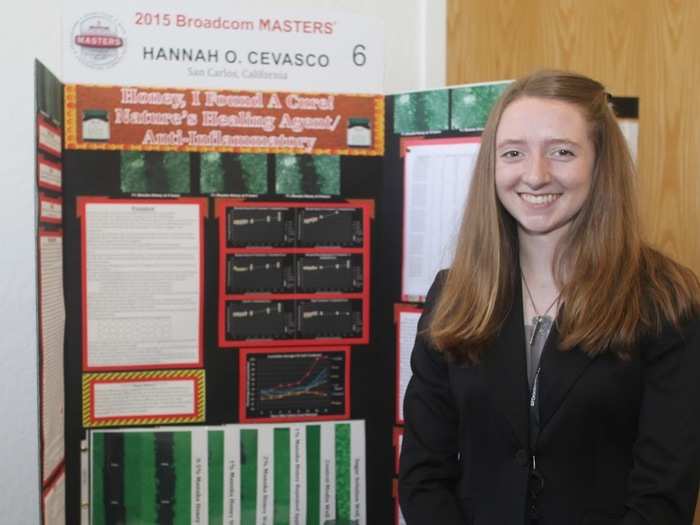
Hannah Cevasco got into some sticky science with her project, which tested the benefits of Manuka honey on wounded skin cells to ultimately determine if applying the honey to a would would improve healing.
Cevasco tested various diluted concentrations of honey on damaged skin cells and determined that the mixture with 1% honey revealed a "significant affect" on cell improvement. She hopes to test other concentrations to find the optimal mix. She hopes to become a pediatric oncologist.
Hari Anandarao (14) envisions an energy-efficient future.
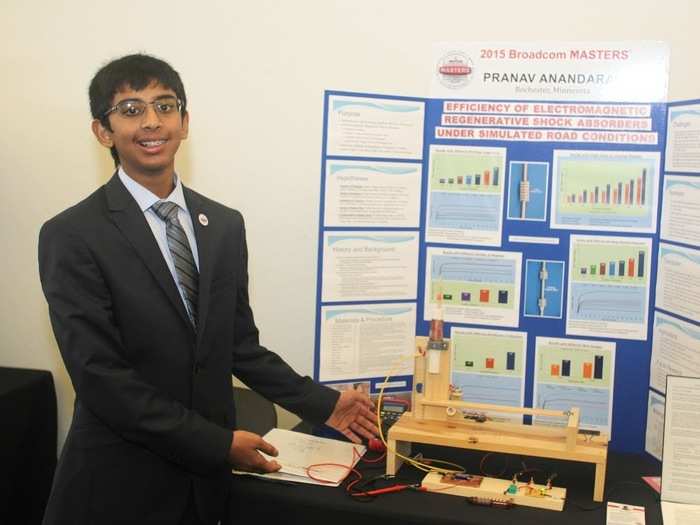
Hari Anandarao understands the importance of energy efficiency when it comes to cars. For his project, Anadarao built his own set of regenerative shock absorbers, which were based on commercial regenerative breaks, which help cars store energy — in the form of heat — that would otherwise go to waste when the vehicle slows down.
Anandarao tested his design to discovery how he could absorb the most energy. Ultimately, he wants to find a career in nanosystems engineering.
Isaiah O'Neal (14) has an interesting collection of carnivorous plants for his scientific investigations.
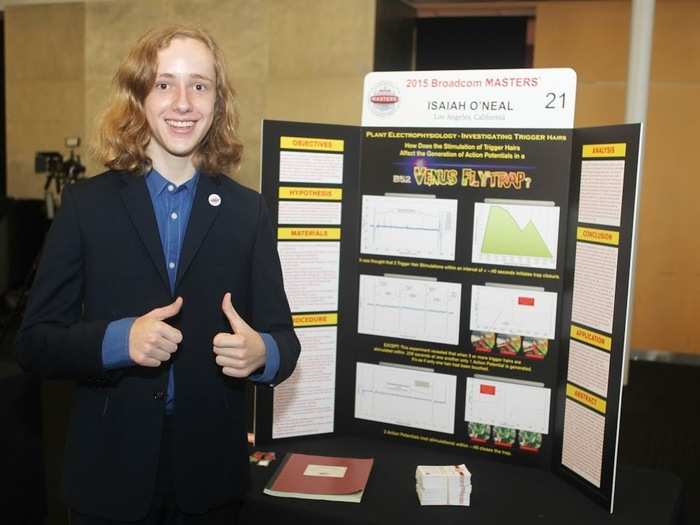
Isaiah O'Neal has a peculiar hobby: He grows Venus flytraps outside his front door. Last year, O'Neal entered the competition with his project that revealed the plants snap their traps faster for certain types of food. This year, O'Neal wanted to learn why.
His project dove into the complex nature of electrophysiology, which describes how electrical signals can travel from a trigger point to the brain in order to generate a physical response. O'Neal discovered that by triggering individual hairs at different times, he could generate multiple responses from the plant. O'Neal also enjoys building robots.
Joseph Huitt (14) says the solution to our honey-bee problem is pollen.
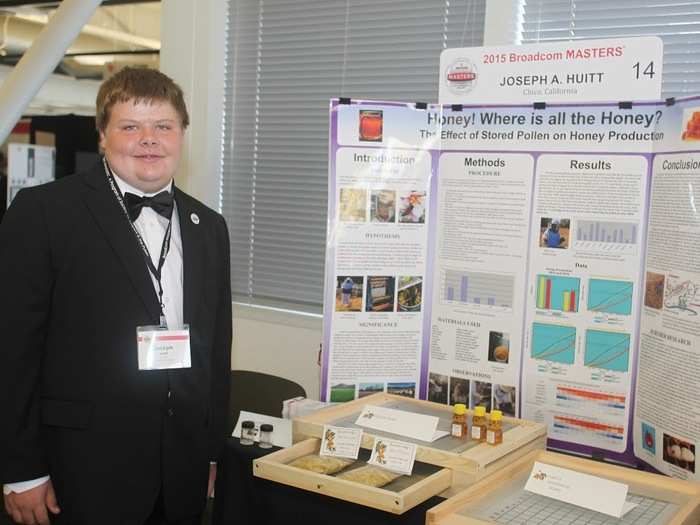
Dwindling honey bee populations is big problem in the US. Joseph Huitt's project, which took two years to complete, investigated whether access to pollen-rich areas could help strengthen bee colonies.
After exposing six dozen beehives to pollen-rich orchards and another six dozen to pollen-free areas, Huitt — whose mother is a commercial beekeeper — discovered that, in general, the bees who had access to natural pollen produced more honey and were healthier than the other bees who were only provided sugar water.
Kanishka Ragula (14) built a better tracking device for solar panels.
Some solar panels come with tracking equipment that guides the panels to follow the sun throughout the day, increasing output. But the equipment can be expensive and difficult to repair.
So, for his project, Kanishka Ragula designed a relatively inexpensive, successful tracker using a piston, which he designed and a machine shop made, and cylinder filled with motor oil. Ragula plans to become a computer engineer.
Madison Toonder (14) studied the effects of sunscreen on oysters.
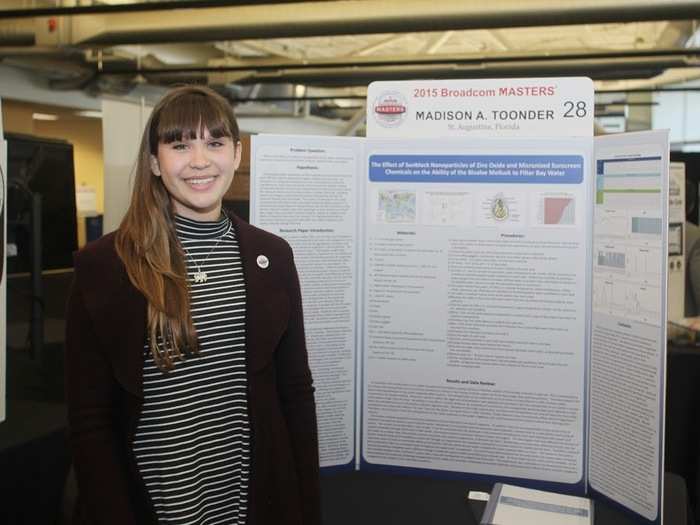
As an aspiring veterinarian, Madison Toonder is concerned for the welfare of wild oysters. Chemicals in the sunscreen that goes from our bodies into the water as we swim or shower can have a fatal affect on oysters, killing them in just five days, Toonder discovered.
Manasa Bhimaraju (11) built a science educational tool that can also be used to teach the blind.
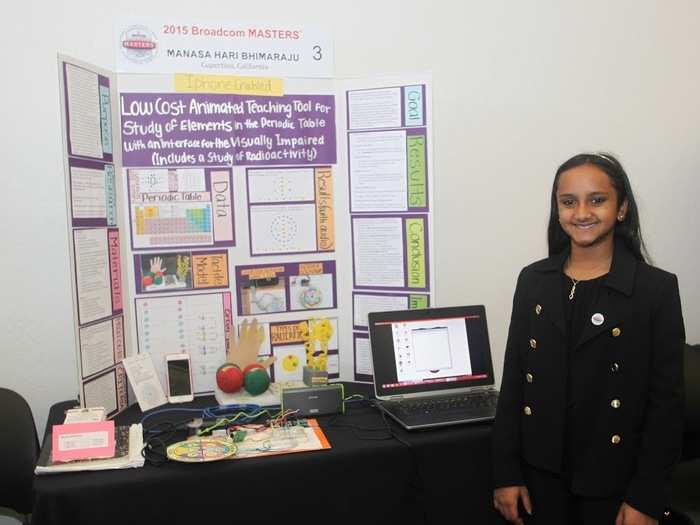
At age 11, Manasa Bhimaraju was the youngest finalist in the competition. Her project involved an educational system that she designed herself and can teach different aspects of the periodic table including the structure of each element's atom and information about radioactivity.
Bhimaraju's system provides the information both visually and vocally, and can therefore be used by visually-impaired students. It also comes with a regular or Braille keyboard. Her system has already been tested by two schools for the blind that are now working to incorporate her system into their classrooms.
Maximilian Du (13) designed a better way to extract caffeine from liquids.
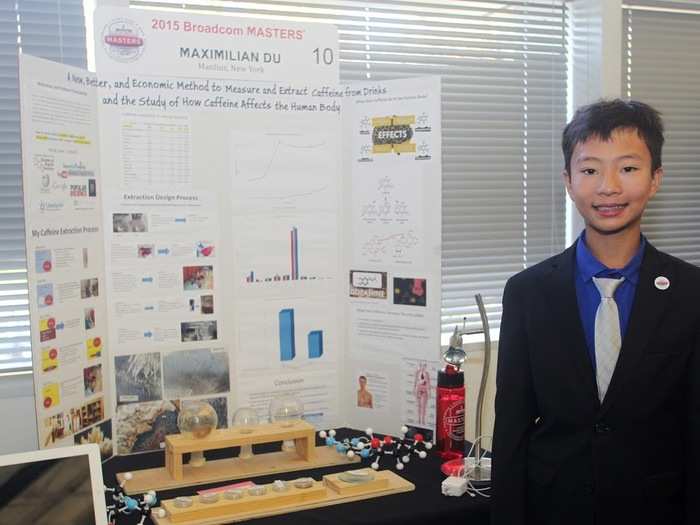
Extracting caffeine from beverages is an incredibly complex and expensive process, but that didn't stop Maximilian Du, who wanted to measure caffeine levels in different drinks like coffee and tea.
Instead of giving up, he developed a completely new method for extracting caffeine that yielded results similar to current, more expensive techniques. Du plans to become a chemist or chemical engineer.
Mikayla Lindsay (13) wants to learn how to build force fields, but for now she'll settle for a different kind of field.
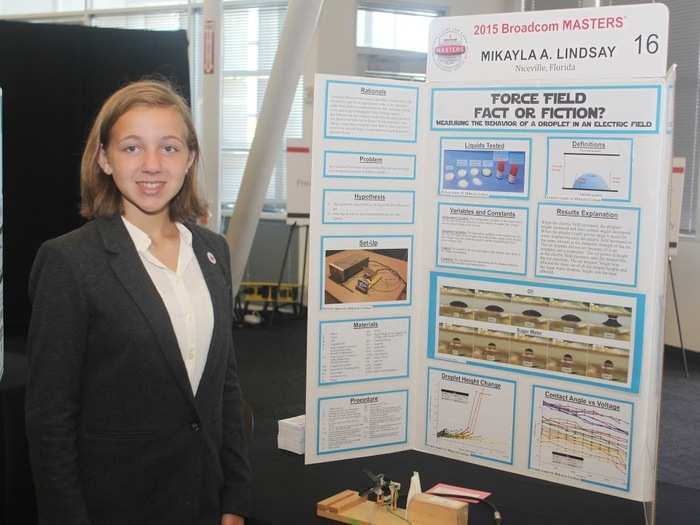
Mikayla Lindsay is fascinated by the force fields that protect people in sci-fi films like Star Wars. So, for her project she wanted to see if she could take a small step toward making one. Ultimately, she levitated droplets of different liquids using electric fields.
Lindsay discovered that sugar water, not the salt water, regular water, or two oils she tested, experiences the greatest increase in height when she jacked up the power of the electric field. Lindsay hopes one day to become an astronaut.
Natasha Chugh (14) built a device that could change your morning routine.
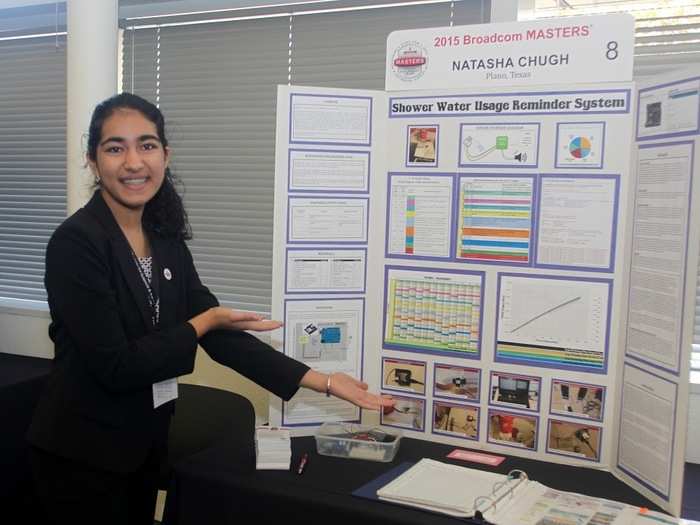
Natasha Chugh's concept is simple: Get people to waste less water. Her device, however, required a sophisticated level of engineering.
Chugh designed a device that measures how much water you have used at any given point during your morning shower, and announces when you've passed certain thresholds. Pass too many, and the device will start to blare obnoxious alerts. Chuge has a third-degree black belt in Taekwondo and plans to become a medical doctor.
Naya Menezes (14) enjoys shooting high-speed balls at mannequins — all in the name of science.
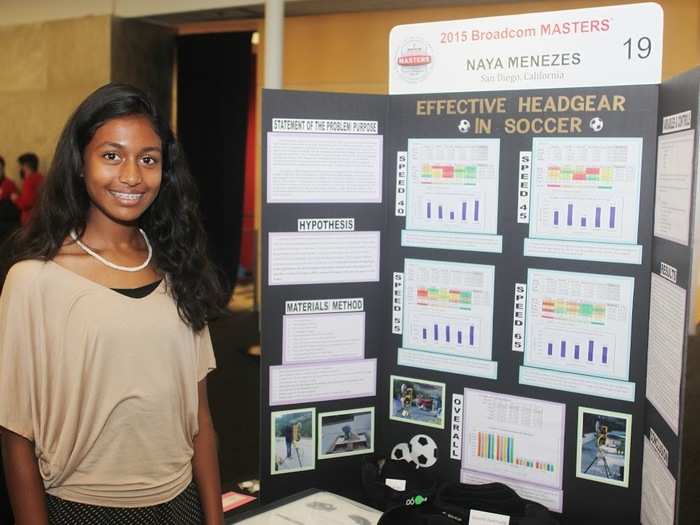
For her project, Naya Menezes pummeled a plastic mannequin with fast-moving sports balls, but not before protecting the dummy with different types of head gear. Menezes wanted to figure out how effective different head gear was at absorbing the force from a high-speed ball, so she recorded the acceleration the head gear experienced after impact to calculate force.
She then analyzed the data of 1,680 hits on her computer and reported that each head gear reduced more force from balls moving at 45 mph than at any other speed. Menezes wants to become a computer engineer.
Nichloas Perez (13) is concerned for the lives of firefighters.
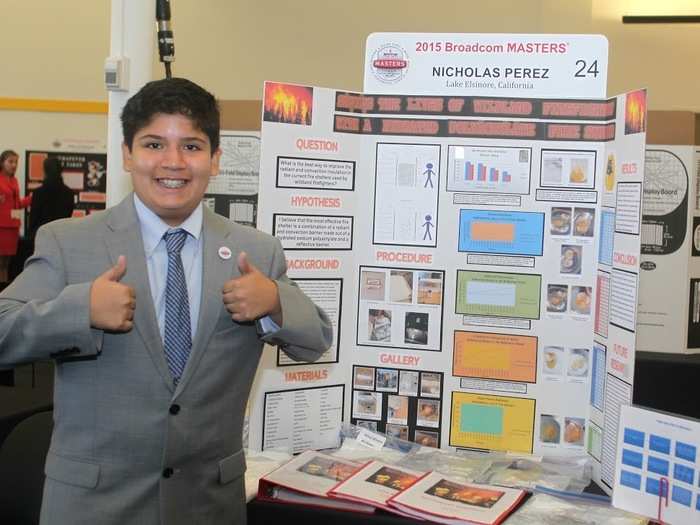
Nichloas Perez is out to save the lives of men whose job is to do exactly that: firefighters. Last year, Perez developed a fire resistant material, which he has now designed into fire shelter that firefighters could use to protect themselves in the field from three different forms of heat: radiation, conduction, and convection.
Nick is currently in a mentorship program at a lab that studies genetic research and he hopes to become a biomedical engineer.
Nikolai Ortiz (12) uncovered a dirty secret of polluted waters.
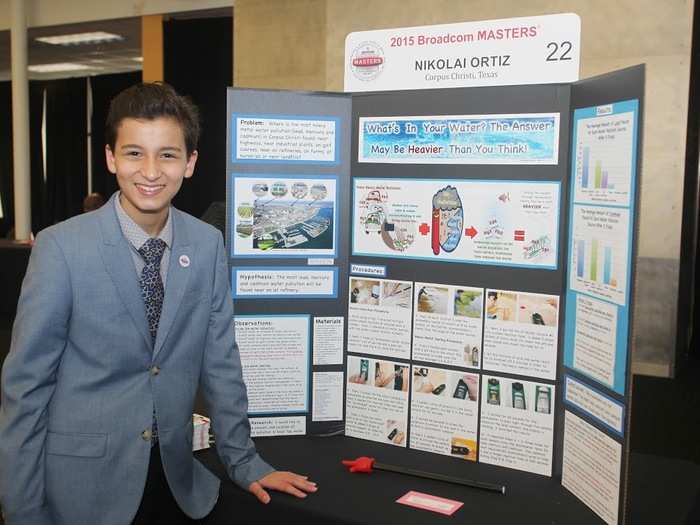
Nikolai Ortiz saught out pollution in landfills, golf courses, industrial plants, oil refineries, and more for his project that investigated levels of the chemical toxins lead, mercury, and cadmium in water around these areas. He was surprised to discover that the most-polluted water was in a ditch by a highway and not near the oil refineries, like he expected.
Ortiz hopes to one day become what he called an Environmental Imagineer. "As an Environmental Imagineer I will create eco-friendly technology that can be used to run pollution-free, environmentally friendly theme parks and resorts that run on renewable energy," he told the Society for Science and the Public.
Rohit Mital (13) made a shocking discovery about about certain pollution control equipment.
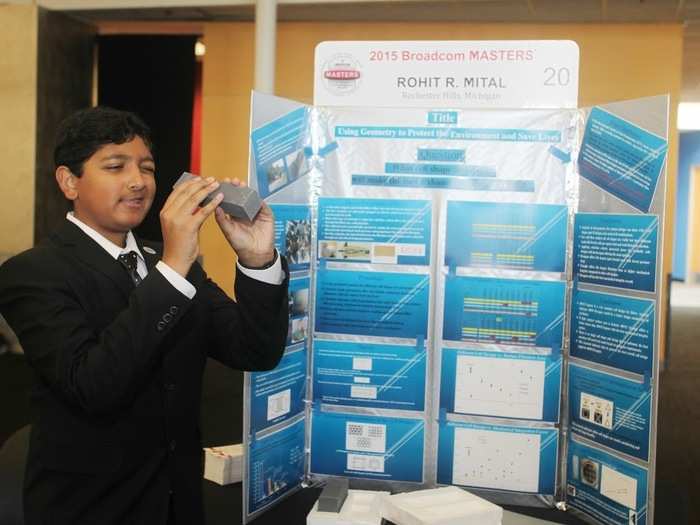
Rohit Mital experienced first-hand severe levels of air pollution during his visit to Asia. So, for his project, he investigated the efficiency kinds of catalytic converters, which are a type of pollution control equipment for transportation vehicles.
He discovered that of the 45 designs he studied, only 19 met minimum requirements. Mital hopes to become a surgeon.
Soyoun Choi (16) discovered the benefits of being bilingual.
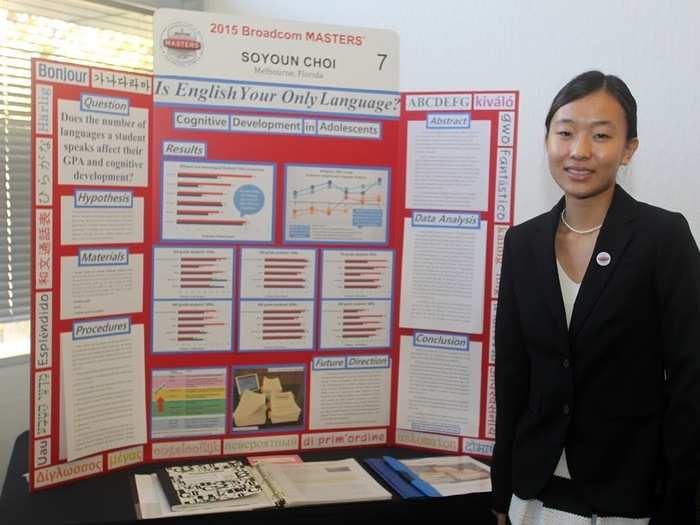
Soyoun Choi was raised to learn both English and Korean — something she reports resenting at the time. But after her project, which surveyed students at her school and a nearby school, she's grateful.
After observing and comparing the grades of bilingual and monolingual students in core subjects, Choi found that bilingual students, on average, score lower in reading and language arts but higher in math and science. What's more, bilingual students generally have a higher GPA, as well. Choi hopes to become a robotics engineer some day.
Sriyaa Suresh (13) studied the effects of thirdhand smoke.
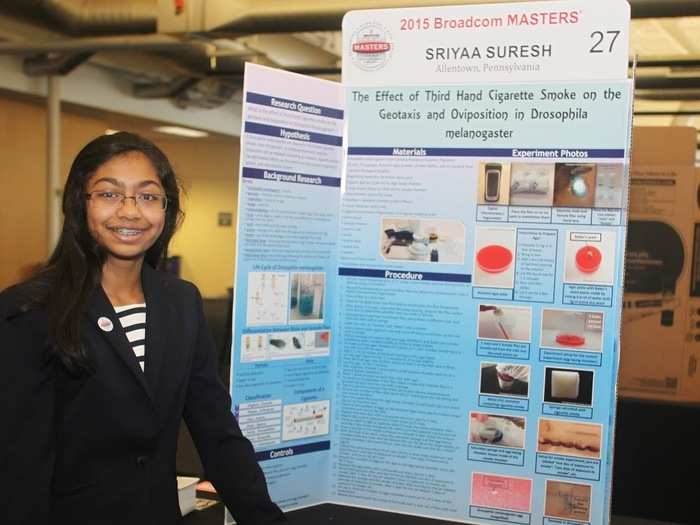
We know that secondhand smoke can be harmful to human health, but what about that distinctive after-smell and residue that can remain in the air and on clothes. That's thirdhand smoke, and according to Sriyaa Suresh, it might also be harmful.
Suresh exposed fruit flies to thirdhand smoke and discovered that after it affected both egg laying and climbing ability. Suresh plans to become a medical doctor.
Sabastian Mellen (14) has an app for the mathematically-apt.
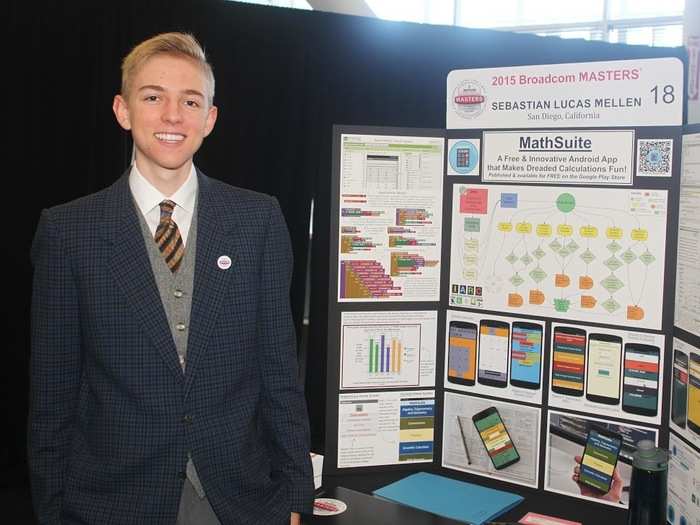
Sabastian Mellen took home the $10,000 prize for his design of a sophisticated app he calls MathSuite, which makes dreaded calculations fun, as he describes it. Mellen jumped through a number of hoops to get the app working properly, including making sure the app didn't consume too much memory, was easy on a phone's battery usage, and easily searchable in Google Play.
You can download MathSuite on Google Play. Mellen says that he continues to respond to user request to improve the app and that his user base is constantly growing.
Annie OstojicI (13) designed a more energy-efficient microwave.
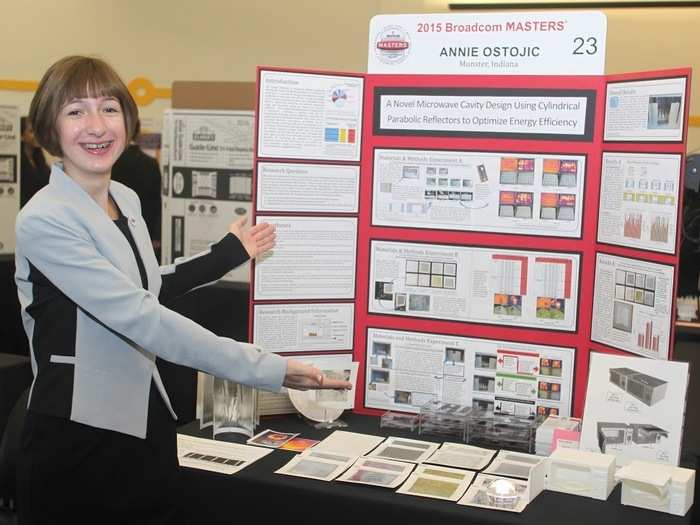
When she's not zip-lining, parasailing, or indoor sky-diving, Annie Ostojicl is figuring out ways to improve microwave technology. And she now has $25,000 to show for her work.
Ostojicl's project involved a novel design for the interior of a microwave to reduce lost heat and improve efficiency — that she tested by seeing which of her designs best cooked a marshmallow. Now, that's some tasty science!
Popular Right Now
Advertisement